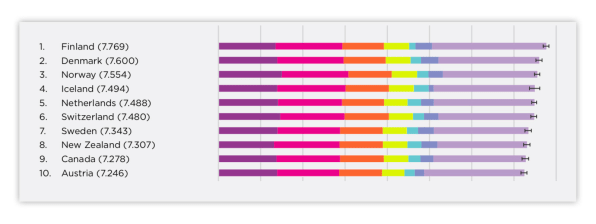Are you surprised that the U.S. isn’t one of the 10 happiest countries on earth?
The top three countries with the highest sustained levels of happiness in recent years are Finland, Denmark, and Norway, in that order. Next up, it’s Iceland and the Netherlands to round out the top five. Switzerland, Sweden, New Zealand, Canada, and Austria make up six through 10.
Where’s the U.S.? It just barely made the top 20. It places 19th overall based on the annual rate of happiness that citizens reported over a three-year period from 2016 to 2018, according to the 2019 World Happiness Report compiled by the Sustainable Development Solutions Network (SDSN).
The report’s calculations are based on Gallup surveys of at least 1,000 people in roughly 140 countries each year. Gallup asks respondents to imagine they’re climbing a ladder with steps numbered between one and 10. The top steps represent their best possible life, and it gets worse toward the bottom. The organization then asks each person which rung feels closest to how they currently feel.

In the U.S., the average stops at roughly 6.8. Among the top three countries, it climbs to at least 7.5 or higher. In more detailed polls, Gallup has drilled down on what factors play into that. The report notes the importance of communities with strong social support, a healthy economy, and high life expectancy. Freedom around life choices, others acting generously, and a general lack of societal corruption also play a part.
Researchers also tracked what countries have made the biggest increases or decreases over the last decade by comparing each place’s recent average to a yearly average from 2005 to 2008. Shifts generally correlate with increased societal stability or upheaval. According to the report, mood improvements over the last 10 years have occurred in Benin, Nicaragua, and Bulgaria. The steepest drops occurred in Venezuela, Syria, and Botswana, all of which are rife with conflict.
Overall, happiness in the United States actually decreased nearly a half-rung over the last decade. That may be cause for some concern: After all, people’s happiness is generally good shorthand for how content they feel, and whether they feel their lives are moving in the right direction.
Gallup has previously shown how continued declines in seemingly stable places might be a predictor of future upheaval. In the case of Brexit, for instance, while the United Kingdom’s GDP increased steadily for roughly a decade, its happiness rating fluctuated–and then declined sharply in the three years leading up to the 2016 referendum to leave the European Union. In Egypt and the Ukraine, the same inversion presaged massive protests and social uprisings in 2011 and 2014, respectively.
The report also points to several trends that may be making Americans feel less good about themselves (or are at least correlated), including substance abuse and, for young people, especially, an uptick of mobile-phone-related activities. “Government, business, and communities should use these indicators to set new policies aimed at overcoming these sources of unhappiness,” says SDSN director Jeffrey Sachs in an announcement accompanying the report.
(13)



